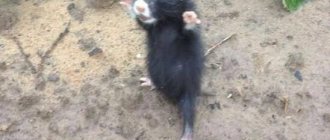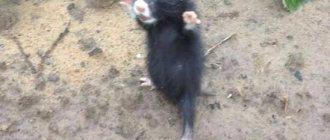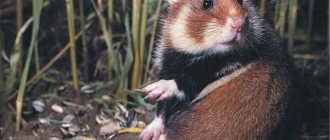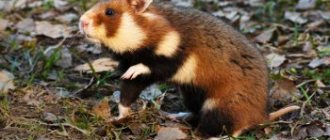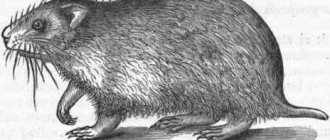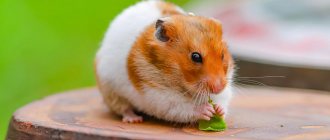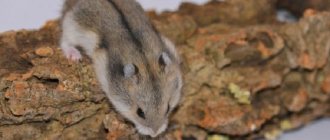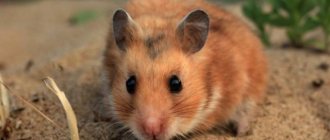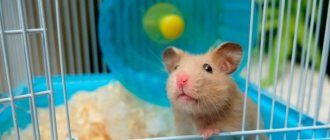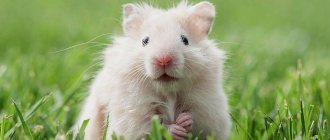- home
- Kinds
01.11.2018 The field hamster is a very beautiful and large animal that knows how to stand up for itself and its territory and intelligently organizes its life. Behind the sweet appearance lies a persistent character and the ability to survive in difficult conditions, fearlessness when meeting the enemy.
What does a wild hamster look like?
It has some similarities with the domestic hamster, but differs from it in size. An adult male reaches a length of 37–39 cm and weighs up to 700 grams. The female is slightly smaller, but also quite impressive.
The field hamster has a rounded body, practically devoid of a neck, so the transition from head to body is imperceptible. The tail is 3–8 cm long, thick near the base and tapering to the tip.
Photo of a field hamster
The muzzle is of medium length with a stiff mustache and black shiny eyes. The ears are small, round, covered with dark hairs.
The teeth of a wild hamster are very long and sharp. During life they are constantly worn down and renewed.
The legs are short and strong, sometimes it seems that the hamster is crawling on the ground. The common hamster has well-developed feet and toes with long and hard claws, which are adapted for digging holes and holes.
The body of the karbysh is covered with dense soft wool with undercoat. The color of the animal is varied. There are specimens that are reddish-brown or yellow in color with a dark undercoat. There is a black and white pattern on the surface of the body.
Usually the abdomen is black in color. There are light spots on the sides, which are separated by black lines. Light spots may be present on the sides of the head, in the area of the shoulder blades and behind the ears.
Photo of a wild hamster
Very rarely in the wild there are individuals with black coloring, in which white spots are located only on the throat and paws.
The lifespan of a rodent in the wild is 4 years.
Is it a protected animal?
In recent years, the hamster population has declined sharply. Scientists attribute this to a decrease in female fertility. Previously, the litter consisted of 10-12 cubs. Now their number has decreased to 3-6 individuals. This is due to the active use of pesticides by humans in agriculture.
Until the middle of the 20th century. In Europe and the USSR, animals were hunted for their fur. Massive fishing and the active use of pesticides in agriculture have also led to a reduction in the number of rodents.
In some European countries, the wild hamster is on the verge of extinction. In France, Belgium, Poland, and Germany, rodents are protected. Measures are being taken to restore the animal population. A decrease in the number of rodents has been recorded in Russia. In 5 constituent entities of the Russian Federation, the hamster received conservation status. Animals are protected in Tatarstan, Tambov, Nizhny Novgorod, Penza and Lipetsk regions.
In some countries the hamster is on the verge of extinction.
Living conditions
The wild hamster is widely distributed from southern and central Europe to northwestern China. It prefers forest-steppes, steppes and mixed-grass meadows. Currently, the rodent's habitat has expanded somewhat. This is due to massive deforestation.
The hamster is not afraid of human proximity, so it willingly explores the territories of personal plots, fields, orchards, and vegetable gardens. If there is not enough food, it can settle in a living room.
The field hamster is not afraid of harsh winters or cold climates. He takes refuge in his hole. The karbysh’s home has an interesting structure. It consists of several rooms and nests. The length of a wild hamster's burrow can reach 8 meters wide and 1.5 meters deep. It has up to 10 outputs, several of which are false.
Photo of a common hamster in nature
Animals are most active in the evening and at night. During the day they hide in a hole.
Rodents do not have a good disposition and show aggression towards everyone, even humans. Males are only friendly to females during the breeding season.
Hamsters are solitary animals and protect their territory. They can attack an intruder, regardless of its size.
Karbysh lifestyle
Like other rodents, carbysh prefers to lead a nocturnal lifestyle. During the day it hides in a hole, and in the evening it comes out to inspect the property and replenish supplies. The “storage room” of a field hamster is designed for a comfortable existence for several months.
Hamster burrows are 5–10-meter labyrinths with separate compartments for storing supplies, resting and sleeping, and even a toilet. Karbysh prefers to use ready-made tunnels that have already been dug by gophers or other rodents. The hamster can easily drive them out, but more often he picks up abandoned holes, which he then skillfully modernizes. The animal's burrows are clean. The animal is an example of a zealous owner.
During the warm season, he is actively engaged in replenishing supplies, expanding the territory, and taking care of procreation. A slow metabolism allows him to sleep in winter.
In Russia, field hamsters are common in the Caucasus, Altai and Siberia. The habitat of the animal includes Kazakhstan and China, many European countries.
What does it eat in nature?
The rodent is omnivorous. He has a good appetite. The main diet consists of plant foods, but in spring and summer it will not refuse insect larvae, small reptiles, crustaceans and mollusks.
With the onset of autumn, the animal consumes more plant foods. At this time, the hamster's harvesting season begins. The field hamster's diet is based on corn, peas, grains of wheat, buckwheat, millet, potatoes and carrots, the reserves of which he stores in pantries.
Wild hamster - carbysh
The rodent creates supplies thanks to its cheek pouches, which it uses to carry food. One bag holds up to 50 g of grain, which the animal can carry over a distance of more than a kilometer, supporting the bags with its front paws.
Wild hamsters store large amounts of food in their burrow. Burrows with huge reserves were discovered, hundreds of times exceeding the rodent's own weight.
Karbysh eat food while sitting on its hind legs. He eats by holding the food with his front paws and stuffing the food into one cheek, then the other, then quickly chews it.
Hibernation season
Nature took care of the little creature and gave him the opportunity to endure the winter cold in a warm hole. From October to February, the steppe hamster hibernates. He can sometimes wake up, eat and go back to sleep. The animal regains its strength so that with the onset of spring it can once again fight for survival.
The rodent wakes up when the ground warms up. Usually this is the end of February or the beginning of March. But it does not immediately come to the surface. For about a month it will intensively consume reserves and only then open the entrances and exits.
Females emerge from the burrow in the spring later than males, when mating season approaches.
While the hamster in the steppe sleeps sweetly in its winter burrow, its relatives at home are awake. “Domesticated” animals do not go into hibernation.
Reproduction
The breeding season for wild hamsters begins in April and lasts until the end of October.
The female reaches sexual maturity at 3 months. The gestation period is 16 days, so during the summer she manages to bear offspring 2–3 times.
Males show interest in females only during mating, after which they immediately leave her. Often one rodent creates families with several females. The male does not take any part in caring for the offspring.
The average number of cubs is 10 – 18. Babies are born blind and naked. Newborns weigh only 4–6 grams. The cubs develop very quickly. At the age of two weeks, hamsters open their eyes and become covered with fur.
Common field hamster
The feeding period is 20 days, but after 7–10 days the cubs are able to eat solid food. The mother closely monitors the offspring and, in case of danger, moves the cubs to a safe place.
In the wild, rodents are unable to protect themselves from attacks by predators. Natural enemies make it possible to control the population of these animals. Birds of prey, wolves, lynxes, and foxes pose a threat to the field hamster. They may be attacked by cats and dogs in the garden area.
Features of the view
Steppe hamsters differ from their counterparts in their great love of water and swimming, which they do very easily. The animal has special bags in its cheeks that swell and help the animal float on the water. Hamsters also have another feature: a passion for fresh meat. Sometimes brave animals attack rabbits, gnaw their necks and eat their flesh with pleasure.
Due to their aggressiveness, hamsters managed to acquire enemies, which benefits humans. Birds of prey are frequent destroyers of the population, but quite often people have to fight the animals on their own. Despite the aggressive behavior of steppe rodents, it is important to recognize that the steppes and mixed territories received a unique animal as a representative of the fauna world for their lands.
Difference between wild and domestic hamster
Wild hamsters differ from tame pets not only in size and appearance. Rodents are quite aggressive and pose a danger to humans, and once settled in a garden or vegetable garden, they can threaten future harvests.
Unlike wild hamsters, domestic animals have a calmer and more docile character and are easily tamed.
Wild hamster eats blackberries
The common field hamster cannot be tamed, so it is much easier and safer to purchase a pet hamster.
It is not advisable to purchase several rodents, since rodents of different sexes will constantly produce offspring, and rodents of the same sex will fight.
Why did wild hamsters appear in the country? How to get rid of it?
With the onset of summer, wild hamsters often take up residence in gardens and vegetable gardens. This is due to the ripening of the crop and the beginning of the harvesting season for animals.
Rodents cause enormous harm to homestead farms. The large number of wild hamsters and the ability to adapt to any conditions allows them to quickly develop territory, and the ability to build complex burrows makes them difficult to destroy.
The presence of a hamster in the garden can be guessed by the following signs:
- tunnels and exits from holes. In the hamster they are wider than in moles and shrews;
- damaged bark in the lower part of fruit trees, since animals like to gnaw the bark at the very bottom, near the roots;
- digging in carrot beds and near potato bushes;
- the presence of characteristic small marks.
Common hamster
Currently, farmers and summer residents use different ways to deal with uninvited guests.
- Flooding holes. To do this, close all exits from the hole and pour water until the hamster crawls out. If not all emergency passages are closed, the animal can get out and run away.
- Digging holes and catching by hand. Very labor-intensive and dangerous.
- Use of traps and snares. The devices are effective, but it is very difficult to track where to install them
- Poisoned baits. Rat and mouse poisons are most often used. The disadvantage of use is the destruction of a small number of pests. Domestic cats and dogs may also be affected.
- Use of noise and ultrasonic repellers. Quite a costly method. Also, protecting a large area will require a significant number of devices.
Hamster hole
The steppe hamster spends most of its life in a burrow. This is not at all due to the fact that he is afraid to leave the confines of his home. The animal is quite fearless. But to hunt, he needs a lot of rest.
The hamster hole goes 1-2 meters deep into the earth. It all depends on how easy it is to dig the soil. The basis of the house consists of:
- living chamber;
- inclined exit;
- steep entrance.
The living chamber, in turn, has three “doors”. The first two are intended to ensure that the animal can freely enter home and leave if necessary. And the third door is oriented to the room with supplies. Only in winter and early spring does the hamster use products from there; on other days its diet consists of fresh grains, vegetables and fruits.
How to identify a hamster? You can do this based on characteristic buildings. They are easily recognized by small piles of earth located directly near the inlet/outlet. They are sprinkled with grain husks on top.
Using a small stick, you can find out whether a rodent lives in the found hole. It needs to be placed inside and then pulled out. If cobwebs, moss, husks or grass are found on it, then the dwelling is abandoned. No hamster would keep his house in disarray.
What to do if bitten by a wild hamster?
The bite of a field hamster is very dangerous for both humans and domestic animals. The animal's teeth are very sharp and long, and when they bite, they leave deep wounds with ragged edges. In addition, fleas living on the body of a rodent are carriers of infectious diseases.
If a rodent does bite, you should immediately wash the wound with warm running water and soap and treat it with a disinfectant. To do this, you can use alcohol, hydrogen peroxide, iodine, brilliant green.
Swelling and redness may appear at the site of the bite. In severe cases, the temperature rises, general weakness and difficulty breathing occur. To prevent unpleasant consequences, you should seek emergency medical help, which includes a course of injections for tetanus and rabies.
Interesting Facts
The steppe hamster is a rather entertaining rodent. Not surprisingly, there are a lot of interesting things associated with it:
- These rodents are considered carriers of about 30 dangerous infectious diseases. And at the sites of their bites, lacerations often remain.
- Until the mid-1940s, the wild hamster was considered a fur-bearing animal. The fur of the steppe rodent was widely used in the clothing industry. True, to make 1 fur coat, 200-250 skins are required.
- The animal has several alternative names. It is often called “karbysh”, “common hamster”, “forest”, “garden” or “garden” hamster.
